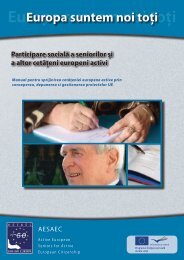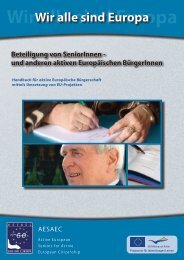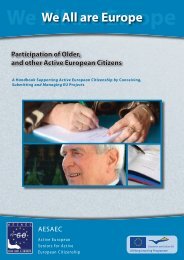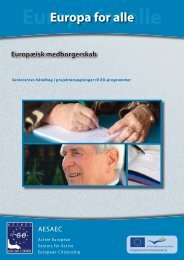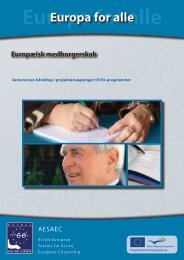We All are Europe - AESAEC
We All are Europe - AESAEC
We All are Europe - AESAEC
You also want an ePaper? Increase the reach of your titles
YUMPU automatically turns print PDFs into web optimized ePapers that Google loves.
Authentic Location Learning, Multi-sensorial Learning and Learning by Doing<br />
That is why methods and instruments <strong>are</strong> applied which correspond to the overall sensory attentiveness<br />
potential of the learners and which actively use learning potential.<br />
III.4. Learning by Doing<br />
Also learning by doing is a relatively old term in educational theory, which in this form was first<br />
introduced by the boy-scout founder Robert Baden-Powell, but on the other hand is based on older<br />
models of action-orientated learning (like for example from John Dewey). The concept of applied<br />
learning is regarded as being sufficiently well known, so that a comprehensive explanation of it<br />
does not seem necessary here. It is necessary however to highlight that <strong>AESAEC</strong> must be seen in its<br />
entirety, as an attempt to establish a sustainable Learning by doing concept. Thus the EU cofinanced<br />
project <strong>AESAEC</strong> is just the starting point for a long-term process. Through the project the<br />
course participants <strong>are</strong> sensitised and equipped so they can independently take part in EU projects,<br />
in order to experience a more active sense of <strong>Europe</strong>an citizenship, to contribute to the shaping of<br />
<strong>Europe</strong>an processes and to speak up for one’s own interests and needs. That the pedagogical concept<br />
of the course extensively uses elements of Learning-by-doing is only too logical and consistent.<br />
However the actual and long-term calculated effect of Learning-by-doing is felt, above all, towards<br />
the end or after the <strong>AESAEC</strong> course, when the participants have conceived and submitted their project<br />
proposals and in particular when these – in the case of a project being approved – can actually<br />
be implemented. It is then that the participants, through active Learning by doing, <strong>are</strong> fully capable<br />
to learn about the <strong>Europe</strong>an Union, EU funding mechanisms, EU project management, interculturalism,<br />
intercultural cooperation and problem-solving approaches. In addition they can further develop<br />
themselves but also their surroundings – and as a final consequence – the <strong>Europe</strong>an idea.<br />
Bibliography:<br />
Andersson, Sven/Andersson, Ingrid (2005): Authentic Learning in Social-cultural Frameworks. Taylor & Francis.<br />
Clark, Aldrich (2005): Learning by Doing: A Comprehensive Guide to Simulations, Computer Games, and Pedagogy in e-<br />
Learning and Other Educational Experiences. Pfeifer.<br />
Coffield F. et alii (2004): Learning styles in pedagogy in post-16 learning. A Systematic and Critical review. London. Learning<br />
and Skills Review Centre.<br />
Dörig, Roman (2003): Handlungsorientierter Unterricht - Ansätze, Kritik und Neuorientierung aus bildungstheoretischer,<br />
curricul<strong>are</strong>r und instruktionspsychologischer Perspektive. WiKu-Verlag.<br />
<strong>Europe</strong> at Work (2007): <strong>Europe</strong> Cooks at Work. ( www.europe-at-work.eu)<br />
Land Brandenburg/Ministerium für Bildung, Jugend und Sport (Hg.) (2005): Außerschulische Lernorte. LISUM.<br />
Lawrence, Gordon D. (1997): Looking at Type and Learning Styles. Center for Applications of Psychological Type.<br />
Lombardi, Marilyn (2007): Authentic Learning for the 21 st Century: An overview. EDUCAUSE.<br />
Montessori, Maria (2009) [1919]: The Montessori Method. Wilder Publications.<br />
Museum Nuremberg/Documentation Centre Nazi Party Rally Ground: Learning in Authentic Locations: The Education Forum.<br />
(http://museums.nuremberg.de/documentation-centre/education-programme.html)<br />
Niederhauser. Rolf/Rhyn, Heinz (2004): Lernen außerhalb der Schule. Das Projekt MatI – Marktplatz für außerschulisches<br />
Lernen. Haupt.<br />
Reyher, Uwe (Hg.) (1998): Lernen außerhalb des Klassenzimmers. Außerschulische Lernorte mit Erfahrungsberichten und<br />
praktischen Tipps. Oldenbourg Schulbuchverlag.<br />
Schiffler, Ludger (1998): Learning by Doing im Fremdsprachenunterricht. Max Hueber.<br />
Sliwka, Anne (2001): Das anglo-amerikanische Beispiel. Band 2. <strong>We</strong>inheim<br />
Vogt, Reinhold (2007): Gedächtnistraining in Frage & Antwort. Warum kreatives Denken besser ist als Pauken. Soft Skills<br />
kompakt. Junfermann.<br />
27




